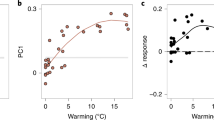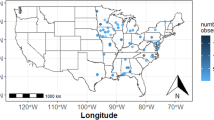Abstract
Trends in phenological phases associated with climate change are widely reported—yet attribution remains rare. Attribution research in biological systems is critical in assisting stakeholders to develop adaptation strategies, particularly if human factors may be exacerbating impacts1. Detailed, quantified attribution helps to effectively target adaptation strategies, and counters recent tendencies to overattribute phenological trends to climate shifts2. Wine grapes have been ripening earlier in Australia in recent years3, often with undesirable impacts. Attribution analysis of detected trends in wine-grape maturity, using time series of up to 64 years in duration, indicates that two climate variables—warming and declines in soil water content—are driving a major portion of this ripening trend. Crop-yield reductions and evolving management practices have probably also contributed to earlier ripening. Potential adaptation options are identified, as some drivers of the trend to earlier maturity can be manipulated through directed management initiatives, such as managing soil moisture and crop yield.
This is a preview of subscription content, access via your institution
Access options
Subscribe to this journal
Receive 12 print issues and online access
$209.00 per year
only $17.42 per issue
Buy this article
- Purchase on Springer Link
- Instant access to full article PDF
Prices may be subject to local taxes which are calculated during checkout




Similar content being viewed by others
References
Parmesan, C., Duarte, C., Poloczanska, E., Richardson, A. J. & Singer, M. C. Overstretching attribution. Nature Clim. Change 1, 2–4 (2011).
Brander, K., Bruno, J., Hobday, A. & Schoeman, D. The value of attribution. Nature Clim. Change 1, 70–71 (2011).
Webb, L. B., Whetton, P. H. & Barlow, E. W. R. Observed trends in winegrape maturity in Australia. Glob. Change Biol. 17, 2707–2719 (2011).
White, M. A., Whalen, P. & Jones, G. V. Land and wine. Nature Geosci. 2, 82–84 (2009).
Rosenzweig, C. et al. in IPCC Climate Change 2007: Impacts, Adaptation and Vulnerability (eds Parry, M. L., Canziani, O. F., Palutikof, J. P., van der Linden, P. J. & Hanson, C. E.) 79–131 (Cambridge Univ. Press, 2007).
Jones, G. V. et al. in XIV International Groupe d’Etude des Systemes de Conduite de la vigne (GESCO) (ed. Schultz, H.) 54–61 (GESCO, 2005).
Grab, S. & Craparo, A. Advance of apple and pear tree full bloom dates in response to climate change in the southwestern Cape, South Africa: 1973–2009. Agr. Forest Meteorol. 151, 406–413 (2010).
Lobell, D. B., Schlenker, W. & Costa-Roberts, J. Climate trends and global crop production since 1980. Science 333, 616–620 (2011).
Brisson, N. et al. Why are wheat yields stagnating in Europe? A comprehensive data analysis for France. Field Crops Res. 119, 201–212 (2010).
Nicholas, K. A., Matthews, M. A., Field, C. B., Lobell, D. B. & Willits, N. H. Effect of vineyard-scale climate variability on Pinot Noir phenolic composition. Agr. Forest Meteorol. 151, 1556–1567 (2011).
Marais, J., Calitz, F. & Haasbroek, P. D. Relationship between microclimatic data, aroma component concentrations and wine quality parameters in the prediction of Sauvignon Blanc wine quality. South Afr. J. Enol. Vitic. 22, 22–26 (2001).
Cozzolino, D., Cynkar, W. U., Dambergs, R. G., Gishen, M. & Smith, P. Grape (Vitis vinifera) compositional data spanning ten successive vintages in the context of abiotic growing parameters. Agr. Ecosyst. Environ. 139, 565–570 (2010).
Rosenzweig, C. et al. Attributing physical and biological impacts to anthropogenic climate change. Nature 453, 353–357 (2008).
Kearney, M. R. et al. Early emergence in a butterfly causally linked to anthropogenic warming. Biol. Lett. 6, 674–677 (2010).
Godwin, D. C. et al. (ed.) in VineLOGICA Model of Grapevine Growth, Development and Water Use (Australian Society of Viticulture and 31 Oenology, 2002).
Nicholls, N. Increased Australian wheat yield due to recent climate trends. Nature 387, 484–485 (1997).
Hope, P., Timbal, B. & Fawcett, R. Associations between rainfall variability in the southwest and southeast of Australia and their evolution through time. Int. J. Climatol. 30, 1360–1371 (2010).
Iland, P. in Viticulture Volume 1—Resources 2nd edn (eds Dry, P. & Coombe, B. G.) Ch. 1., 116 (Winetitles, 2004).
Karoly, D. J. & Braganza, K. Attribution of recent temperature changes in the Australian region. J. Clim. 18, 457–464 (2005).
Frederiksen, C. S., Frederiksen, J. S., Sisson, J. M. & Osbrough, S. L. Changes and projections in Australian winter rainfall and circulation: Anthropogenic forcing and internal variability. Int. J. Clim. Change 2, 143–162 (2011).
Davies, W. J., Bacon, M. A., Stuart Thompson, D., Sobeih, W. & Gonzalez Rodriguez, L. Regulation of leaf and fruit growth in plants growing in drying soil: Exploitation of the plants’ chemical signalling system and hydraulic architecture to increase the efficiency of water use in agriculture. J. Exp. Botany 51, 1617–1626 (2000).
Wheeler, S., Loveys, B., Ford, C. & Davies, C. The relationship between the expression of abscisic acid biosynthesis genes, accumulation of abscisic acid and the promotion of Vitis vinifera L. berry ripening by abscisic acid. Aust. J. Grape Wine Res. 15, 195–204 (2009).
Conde, C. et al. Biochemical changes throughout grape berry development and fruit and wine quality. Food 1, 1–22 (2007).
Zelleke, A. & Kliewer, W. M. Influence of root temperature and rootstock on budbreak, shoot growth, and fruit composition of Cabernet Sauvignon grapevines grown under controlled conditions. Am. J. Enol. Vitic. 30, 312–317 (1979).
Webb, L., Whetton, P. & Barlow, E. W. R. Modelled impact of future climate change on phenology of wine grapes in Australia. Aust. J. Grape Wine Res. 13, 165–175 (2007).
CSIRO and Australian Bureau of Meteorology Climate Change in Australia Technical report (CSIRO and Bureau of Meteorology through the Australian climate change science program, 2007).
Soar, C. J., Dry, P. R. & Loveys, B. R. Scion photosynthesis and leaf gas exchange in Vitis vinifera L. cv. Shiraz: Mediation of rootstock effects via xylem sap ABA. Aust. J. Grape Wine Res. 12, 82–96 (2006).
Stoll, M., Lafontaine, M. & Schultz, H. R. Possibilities to reduce the velocity of berry maturation through various leaf area to fruit ratio modifications in Vitis vinifera L. Riesling. Prog. Agri. et Vitic. 127, 68–71 (2010).
Jones, D. A., Wang, W. & Fawcett, R. High-quality spatial climate data-sets for Australia. Aust. Meteorol. Oceanogr. J. 58, 233–248 (2009).
Raupach, M.R. et al. Australian Water Availability Project (AWAP): CSIRO Marine and Atmospheric Research Component: Final Report for Phase 3 (Centre for Australian Weather and Climate Research, 2009).
Acknowledgements
We wish to thank I. Smith (Commonwealth Scientific and Industrial Research Organisation), A. Gallant and D. Karoly (University of Melbourne), and P. Hope (Australian Bureau of Meteorology) for discussions. S. Tyerman (University of Adelaide) assisted with understanding of berry physiology. G. Jones (Southern Oregon University) located one of the data sets. L. Chambers, I. MacAdam and A. Hobday reviewed the manuscript. Also, we thank N. White (Main Ridge Estate), A. Purbrick and R. Sutherland (Chateau Tahbilk), S. and B. Chambers (Chambers Rosewood Wines), T. Kent and V. Cullen (Cullen Wines, Western Australia), and P. and S. Henschke (Henschke Wines) who all provided information and records, without which this analysis could not have been done. This work was financially supported in part by the Commonwealth Scientific and Industrial Research Organisation Climate Adaptation National Research Flagship and also by the Australian Grape and Wine Research and Development Corporation.
Author information
Authors and Affiliations
Contributions
L.B.W. and P.H.W. designed the study; L.B.W., P.H.W., J.B. and R.D carried out experiments; L.B.W., J.B., P.H.W. and R.D. analysed data; L.B.W., R.D. and E.W.R.B accessed viticulture data sets, P.R.B. provided climate data sets; L.B.W., P.H.W., J.B., R.D. and P.R.B. wrote the manuscript; E.W.R.B. gave conceptual advice.
Corresponding author
Ethics declarations
Competing interests
The authors declare no competing financial interests.
Supplementary information
Rights and permissions
About this article
Cite this article
Webb, L., Whetton, P., Bhend, J. et al. Earlier wine-grape ripening driven by climatic warming and drying and management practices. Nature Clim Change 2, 259–264 (2012). https://doi.org/10.1038/nclimate1417
Received:
Accepted:
Published:
Issue Date:
DOI: https://doi.org/10.1038/nclimate1417
This article is cited by
-
Historical long-term cultivar×climate suitability data to inform viticultural adaptation to climate change
Scientific Data (2022)
-
Analysis of the impact of climate change on grapevines in Turkey using heat unit accumulation–based indices
International Journal of Biometeorology (2022)
-
Influence of weather conditions and projected climate change scenarios on the suitability of Vitis vinifera cv. Carignan in Rioja DOCa, Spain
International Journal of Biometeorology (2022)
-
Gas exchange, vine performance and modulation of secondary metabolism in Vitis vinifera L. cv Barbera following long-term nitrogen deficit
Planta (2021)
-
Effect of seaweed extract application on wine grape yield in Australia
Journal of Applied Phycology (2021)



